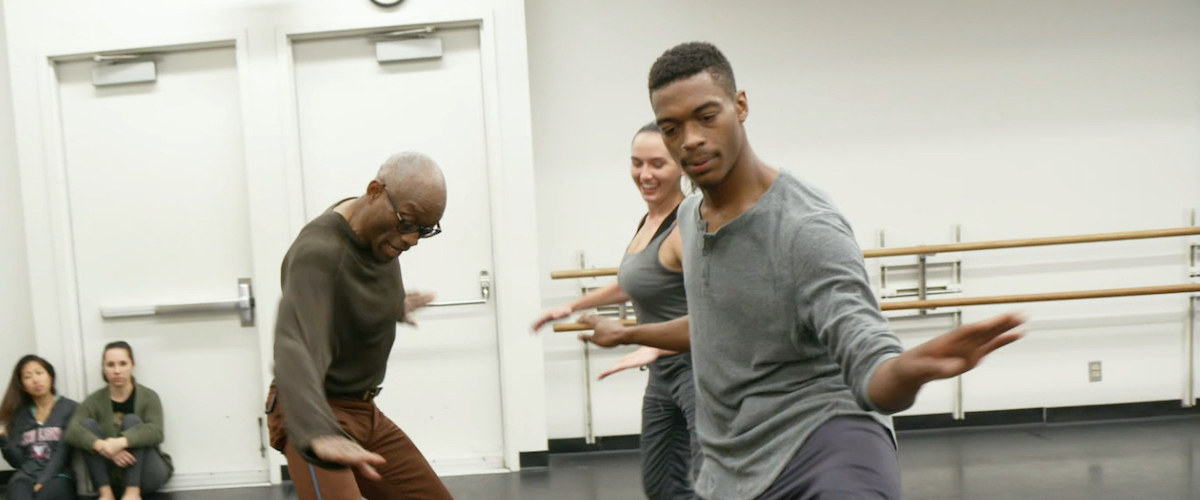Note: This premieres on Black Public Media’s YouTube Channel today, April 3rd.
“It was a place to grieve.” Modern dance choreographer Bill T. Jones says this about his most famous work, “D-Man In the Waters,” which premiered in 1989 to great acclaim (it “radiates life in the face of tragedy” declared one headline). To say “D-Man In the Waters” was a “response” to the AIDS plague is to misrepresent the dance’s origin, intent, and objective. “Response” suggests distance, objectivity, space. “D-Man In the Waters” has no distance, and was created from the center of the maelstrom, immediately following the death of the dance company’s co-founder Arnie Zane from AIDS. Shortly after that, another company member, Demian Acquavella, also contracted AIDS (Damian’s nickname was “D-Man”). One of the company members described not just the dance but the process of creating the dance as a “healing cathartic ritual.” Jones and others are featured interview subjects in “Can You Bring It: Bill T. Jones And D-Man In The Waters,” a history lesson not only about the dance but its surrounding context. It also asks questions about the dance’s relevance outside its own era. Above all that, it is a celebration of the process of creation.
Rosalynde LeBlanc, a former member of Jones’ company (she said she decided to become a dancer after seeing “D-Man in the Waters” when she was 16 years old) and now on the dance faculty at Loyola Marymount University, co-directed “Can You Bring It” with cinematographer Tom Hurwitz. The film operates on a couple of different tracks simultaneously. There are interviews with Jones, and other original members of the Bill T. Jones/Arnie Zane dance company (Arthur Aviles, Janet Lilly, Heidi Latsky, Lawrence Goldhuber, Seán Curran), who talk about 1980s New York, the formation of the company, and the rich and exciting atmosphere of the era right before AIDS arrived. On a separate track, LeBlanc directs her Loyola students in a re-creation of the famous dance, and the film tracks that grueling process from auditions to opening night. Jones himself shows up to witness the students’ progress and provide tips and insight.
LeBlanc faces the challenge of moving “D-Man” out of its original context, where a group of real-life friends came to terms with what was happening to their community (one original company member says, “Half of my phone book died.”). LeBlanc hosts a group discussion about AIDS (shockingly, judging from the students’ responses, knowledge of AIDS has not been passed down), as well as sharing what current-day issues are on their minds. The students have a difficult time translating the issues that matter to them into the dance. They can do the dance moves, but they can’t fill them with intention. LeBlanc’s desire to pull the students out of what she calls their “stasis” is a beautiful thing to see. She has them do exercises to help them connect, and it’s amazing to watch one girl literally dissolve in tears just by looking in the eyes of a fellow dancer. Whether or not the students are “successful” in moving “D-Man” into their own time is not really the point. What matters is the attempt, what matters is the process. Among its many other virtues “Can You Bring It” is a great film about the creative process. People think of the creative process as “inspiration” leading to a triumphant public reveal. But process is sweat, sweat, and more sweat. Watch how specific LeBlanc’s coaching style is, and how helpful such specificity is to the young dancers. At one point LeBlanc senses a certain moment is missing something, and she tells the dancer to really feel the body of the dancer behind her, sink into his body, let his body support hers. The move is totally transformed the next time the dancer does it. It’s expressive and full. When LeBlanc asks the students what’s bothering them, so often the answers have to do only with what affects them in their small sphere. Her directive is to include “us”—the audience, the world.
Interspersed throughout all this is dreamy footage of the current Bill T. Jones company dancers performing “D-Man In the Waters,” on a darkened stage, their bodies launching into the air, backs arched, with dancers underneath stretching their arms up to catch the falling figure. Showing the different sections of the dance, done as they are meant to be done by professional dancers, is very helpful when the scene shifts back to the Loyola rehearsals. We now know what it’s supposed to look like, and what the students are trying to achieve. All in all, it’s very elegantly put together.
“D-Man In the Waters” is a rigorous and relentless dance, requiring a high level of athletic endurance in the dancers. As LeBlanc cautions her students, the dance is not “decorative,” it is not meant to be “pretty.” It is “task-oriented” (her words). Each movement has an objective igniting it. Without the objective, the dance is an “empty shell” (one of her critiques at the dress rehearsal). To see the original is to be caught up in its jubilant breathless whirlwind. Bodies fall to the ground, and swim across the floor on their bellies, bodies are launched into the air, and carried offstage, flopped over another dancers’ back, like soldiers on the battlefield. A woman runs across the back of a hunched-over man and leaps into the arms of a man on the other side. It’s dazzling. “D-Man in the Waters” is a group event, all to the accompaniment of Felix Mendelssohn’s String Octet, a striking dichotomy of music and style. When it’s done right, the dance seethes with feeling so enormous that the dance can barely contain it.
“D-Man” is one of the most eloquent works of art to come out of the AIDS era, and it continues to be done by dance companies around the world. “Can You Bring It” shows the challenges inherent in this, but is also an essential reminder—to people who sorely need it—of just how bad it really was “back then”, when paramedics refused to move the dead body of Arnie Zane out to the ambulance, and the company members present wrapped him up in a sheet and did it themselves, a moment re-created in the dance. They took care of their own. Trauma still exists in those who survived the AIDS era. “D-Man” helps. “Can You Bring It” shows why.
Now playing in select theaters.




















